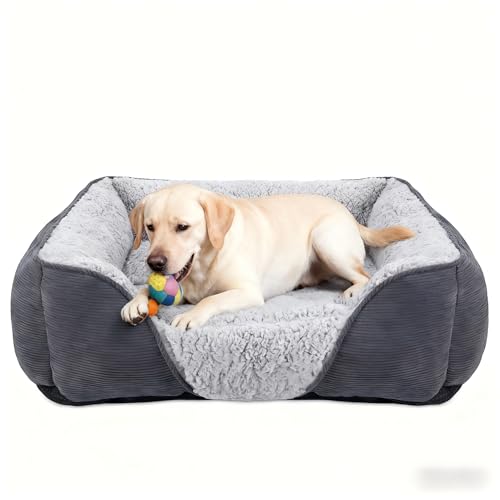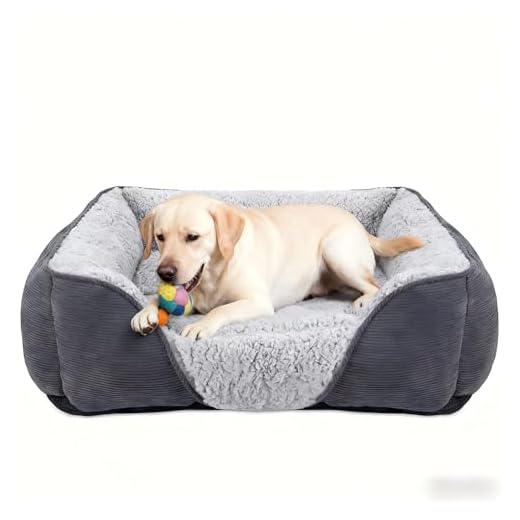




Sharing a bed with a furry friend can bring comfort and warmth, but it’s essential to weigh the factors involved. Research indicates that allowing a canine to rest alongside humans can impact sleep quality, particularly for those with allergies or asthma. The presence of pet dander and potential disturbances from movements during the night might lead to restless nights.
Additionally, consider the temperament and size of the animal. Smaller breeds tend to be less disruptive, while larger ones may require more space, leading to discomfort. Establishing boundaries is crucial; for instance, a designated spot on the bed can provide a sense of closeness without compromising personal space.
Behavioural aspects are also significant. A pet that exhibits anxiety or possessiveness might not be the best candidate for nightly snuggles. Training and socialisation play a vital role in ensuring that both the human and the animal feel secure and comfortable. Regular vet check-ups should also be a priority to maintain the health of the pet and minimise any potential risks.
Ultimately, the decision lies in balancing personal preferences with practical considerations. Creating a harmonious sleeping environment can lead to a fulfilling companionship that benefits both parties.
Assessing Allergies and Health Risks for Pet Owners
Before sharing a sleeping space with a furry companion, it’s crucial to evaluate potential allergy triggers and health concerns. Many individuals unknowingly suffer from pet dander allergies, which can lead to sneezing, itching, and respiratory issues. Regular cleaning of bedding and the surrounding area can significantly reduce allergens. Consider using hypoallergenic bedding materials to minimise exposure.
Consulting with a healthcare professional is advisable if allergy symptoms arise. They may recommend testing to determine specific sensitivities. Additionally, maintaining a routine for grooming and bathing can help limit the amount of dander and dirt in the sleeping environment.
Health risks associated with cohabitation include the transmission of parasites such as fleas and ticks. Regular veterinary check-ups and preventative treatments are essential for both the owner’s and the pet’s well-being. Ensuring that vaccinations are up to date can also prevent the spread of zoonotic diseases.
For those looking to improve their companion’s diet, exploring options such as best dog food sample tasting can enhance overall health, potentially reducing allergies related to food sensitivities. A well-balanced diet supports a healthy coat and skin, which can further minimise allergenic reactions.
Ultimately, being proactive about health and hygiene can create a more comfortable living arrangement for both parties. Regularly assessing any allergic reactions or health issues will contribute to a harmonious environment.
Understanding Your Canine’s Sleep Behaviour and Habits
Monitoring the nightly patterns of a furry companion can reveal much about their wellbeing and temperament. Here are key observations and insights to consider:
- Sleep Cycle: Companions typically experience multiple sleep cycles, including REM (Rapid Eye Movement) sleep, which is crucial for their mental health. During this phase, you may notice twitching or paddling of their legs, indicating they are dreaming.
- Positioning: The way a pet curls up or stretches out can signal comfort levels. A curled position may indicate a desire for warmth and security, while sprawling suggests relaxation and trust in their environment.
- Duration: Adult canines generally require 12 to 14 hours of rest daily, varying by age and activity level. Puppies and seniors tend to need more repose, so be mindful of their individual needs.
I’ve observed that my furry friend prefers to snuggle close during colder nights, often seeking warmth and reassurance. This behaviour not only demonstrates affection but also highlights their instinctual need for safety.
It’s also fascinating to note how environment influences behaviour. A quiet, dimly lit space often encourages deeper rest, while disturbances like noise or movement can disrupt their slumber. I found that keeping the bedroom calm and comfortable has improved my companion’s rest quality remarkably.
- Signs of Discomfort: If a furry friend frequently shifts positions, whines, or appears restless, it may indicate discomfort or anxiety. Address any potential stressors in their surroundings.
- Establishing Routine: Creating a consistent bedtime routine can aid in calming their mind and signalling that it’s time to wind down. Simple practices, like a short walk or gentle play, can set the tone for rest.
It’s crucial to observe any changes in sleep patterns, as they can reflect underlying health issues. Regular check-ups with a vet can help identify any concerns early. I’ve learned to keep a close eye on my companion’s habits, adjusting our environment when necessary to ensure they’re in the best condition possible.
Evaluating the Impact on Your Sleep Quality
Sharing your resting space with a furry companion can significantly affect the quality of rest you receive. It’s crucial to monitor how this arrangement influences your nightly routines. For instance, I noticed that my sleep patterns changed dramatically after welcoming Max into my home. Initially, I struggled with disturbances, but over time, I learned to adapt.
Research suggests that the presence of a pet can lead to both positive and negative effects on sleep. Some individuals report feeling more secure and relaxed, which can promote deeper rest. However, frequent movements or sounds from a pet can interrupt sleep cycles. It’s advisable to observe how your own rest is affected over a few weeks. Keep a journal to track disturbances and overall sleep quality.
Temperature regulation is another factor. Pets can generate heat, which might lead to discomfort during the night. If you find yourself waking up too warm, consider adjusting bedding or providing a cooler spot for your companion. In my experience, using lighter blankets helped maintain a comfortable environment for both of us.
Also, be mindful of the size and behaviour of the pet. Larger breeds may take up more space and could lead to unintentional kicks or nudges during the night. I had to shift Max’s sleeping position to ensure we both had enough room to rest comfortably.
Lastly, consider the emotional aspect. Many people find solace in having their pet nearby, which can reduce anxiety and improve overall mental well-being. Balancing the emotional benefits with practical considerations will lead to better decisions regarding your nighttime arrangements.
Considering the Size and Breed of Your Canine Companion
When choosing to share a bed with a furry friend, size and breed play a pivotal role. For larger breeds, such as Great Danes or Saint Bernards, space becomes a significant factor. These gentle giants can easily take up more than their fair share of the bed, potentially leading to cramped conditions. A good rule of thumb is to assess whether there’s enough room for both of you to rest comfortably without encroaching on each other’s space.
Smaller breeds, like Chihuahuas or Dachshunds, may seem more manageable, but their active nature can lead to unexpected disturbances during the night. Take note of how your little companion behaves while trying to find a cosy spot. If they tend to burrow or shift frequently, it might interrupt your slumber more than anticipated.
Additionally, certain breeds possess distinct sleep behaviours that can influence the decision. Breeds known for higher energy levels, like Border Collies or Jack Russell Terriers, might require more activity throughout the day to ensure they are calm at night. If they don’t expend enough energy, their restlessness could turn into a sleepless night for both of you.
Conversely, breeds that are more laid-back, such as Bulldogs or Basset Hounds, often enjoy a good snuggle and may settle down quickly. Observing how your canine reacts to different environments can offer insights into what sleeping arrangements may work best.
Don’t forget to consider the temperature preferences of various breeds. Some may enjoy the warmth of cuddling up close, while others might prefer a cooler sleeping area. Keeping a close eye on how your furry friend adapts to different conditions will help you create the most comfortable environment for both of you.
In summary, evaluating the size and breed characteristics of your furry friend is crucial. By understanding their specific needs and behaviours, you can create a more harmonious sleeping arrangement that caters to everyone’s comfort.
Establishing Boundaries and Training for Shared Sleeping
Start by creating clear boundaries around the sleeping area. Use a specific spot on the bed or a designated blanket to signal where the animal can rest. This helps maintain personal space while still allowing companionship during the night.
Training is crucial for a harmonious arrangement. Begin with basic commands such as “stay” or “go to your place” to reinforce desired behaviour. Consistency is key. Use positive reinforcement to encourage compliance, rewarding calm behaviour with treats or affection.
Introduce a routine that signals bedtime. This could involve a calming activity, like a short walk or quiet time, to prepare for rest. Reinforcing this routine will help the pet associate these actions with winding down.
Monitor interactions during the night. If the animal tends to move around a lot or disrupts rest, consider adjusting its sleeping location gradually. It may be beneficial to provide a cosy dog bed nearby, allowing closeness without compromising comfort.
Over time, assess the arrangement. If both parties are comfortable and well-rested, it indicates that boundaries and training have been successful. Adjust as necessary to maintain a peaceful sleeping environment for everyone involved.







